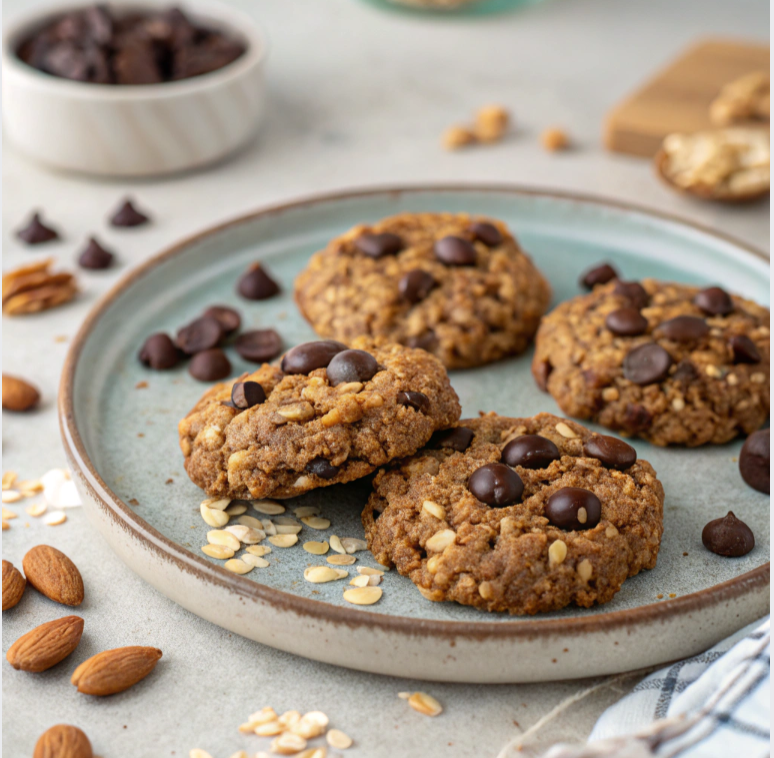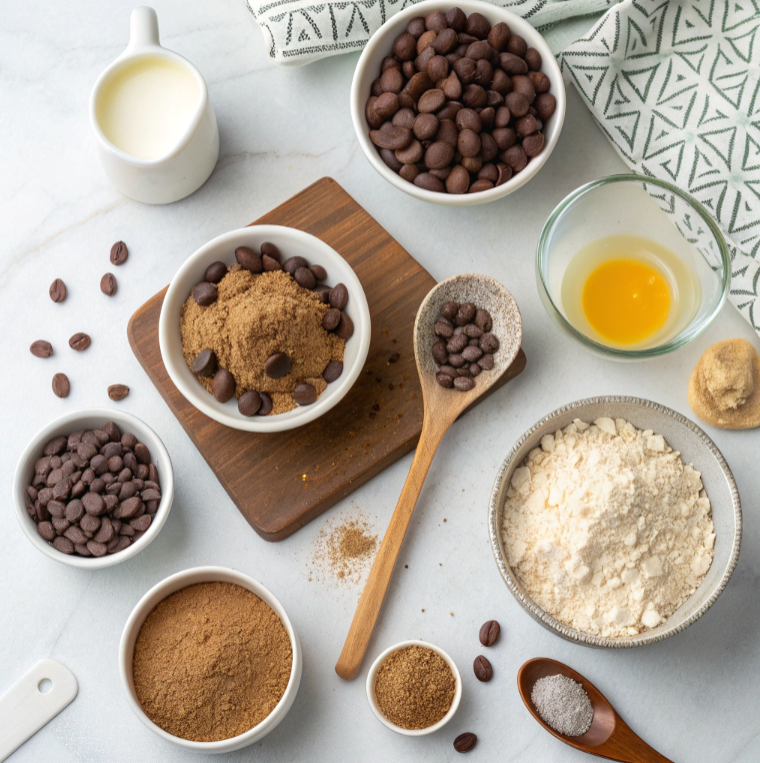
The Science Behind Healthy Baking
Understanding the science behind healthy baking empowers you to make informed ingredient swaps without sacrificing flavor or texture. Baking is a precise chemical process where each ingredient plays a critical role. For example, flour provides structure through gluten, while sweeteners contribute moisture and caramelization.
When substituting ingredients, consider their specific functions. Replacing all-purpose flour with almond or oat flour requires adjustments to maintain the desired consistency. Similarly, reducing sugar might affect browning and tenderness. Healthy chocolate cookies often use alternative binders, such as flaxseed or chia seeds, to replace eggs. These options add nutrients while mimicking the emulsifying properties of eggs.
Leavening agents like baking powder and soda are crucial for achieving a light texture. Experimenting with ratios and testing small batches can help you achieve the perfect balance. Remember, precision and patience are key to successful healthy baking.
Best Flours for Healthy Choclate Cookies
Choosing the right flour is a cornerstone of making healthy chocolate cookies. Traditional all-purpose flour can be replaced with nutrient-dense options for a wholesome treat.
- Whole-Wheat Flour: High in fiber and nutrients, it’s a fantastic base for hearty cookies.
- Almond Flour: Gluten-free and rich in healthy fats, it lends a moist texture.
- Oat Flour: Adds a mild sweetness and is packed with soluble fiber.
- Coconut Flour: A low-carb alternative that absorbs significant moisture, requiring careful adjustment.
- Buckwheat Flour: Despite its name, this gluten-free flour has an earthy flavor ideal for rich chocolate cookies.
Each flour offers unique benefits, so experimenting with blends can create the perfect balance of flavor and texture. Always measure carefully, as alternative flours vary in density and absorbency.
Sweetening Your Healthy Choclate Cookies Naturally
Refined sugars can be swapped with natural sweeteners to craft healthy chocolate cookies that satisfy your sweet tooth without the guilt. Consider the following options:
- Honey: Provides moisture and a rich, floral sweetness.
- Maple Syrup: A plant-based option with a distinct caramel undertone.
- Coconut Sugar: A minimally processed sweetener with a low glycemic index.
- Stevia or Monk Fruit: Zero-calorie options that are highly concentrated, requiring smaller quantities.
Natural sweeteners often add unique flavors, so they’re best paired with complementary ingredients. Adjust other liquids in the recipe to maintain the proper consistency.
Chocolates for Health-Conscious Baking
Selecting the right chocolate is essential for healthy chocolate cookies. Look for varieties with minimal sugar and a high cacao content—70% or more is ideal. Dark chocolate is rich in antioxidants and has a lower sugar content than milk chocolate.
For those seeking dairy-free options, cacao nibs or unsweetened baking chocolate are excellent choices. They offer intense chocolate flavor without added sugars or fats. Remember to check labels for hidden additives or excessive sweeteners. Incorporating high-quality chocolate ensures a decadent, health-focused treat.
Fat Substitutes for Baking
Healthy fat alternatives can transform your chocolate cookies into guilt-free indulgences. Traditional butter or margarine can be replaced with nutrient-rich substitutes, such as:
- Coconut Oil: Adds a subtle tropical flavor and healthy fats.
- Applesauce: Reduces fat content while maintaining moisture.
- Greek Yogurt: Adds creaminess and protein.
- Avocado: Provides healthy monounsaturated fats and a creamy texture.
Each substitute brings unique qualities, so testing proportions is essential for achieving the perfect balance of flavor and consistency.
Tools and Techniques
Using the right tools and techniques elevates the quality of your healthy chocolate cookies. Essential tools include:
- Mixing Bowls: Non-reactive options, like glass or stainless steel.
- Measuring Cups and Spoons: Ensure accuracy for precise ingredient ratios.
- Parchment Paper: Prevents sticking and promotes even baking.
- Silicone Baking Mats: A reusable, eco-friendly alternative to parchment.
Techniques like chilling dough before baking help improve texture and flavor. Using a cookie scoop ensures uniform sizes, leading to consistent baking results.
Healthy Chocolate Cookie Recipes
Crafting healthy chocolate cookies at home is easier than you think. Here’s a simple recipe to try:

Ingredients for healthy chocolate cookies
Ingredients:
- 1 cup almond flour
- ½ cup cocoa powder
- ⅓ cup coconut sugar
- 2 tablespoons flaxseed meal
- ⅓ cup dark chocolate chips
- ¼ cup coconut oil
- 2 tablespoons almond milk
Instructions:
- Preheat the oven to 350°F and line a baking sheet with parchment paper.
- In a bowl, mix almond flour, cocoa powder, coconut sugar, and flaxseed meal.
- Add melted coconut oil and almond milk. Stir until combined.
- Fold in dark chocolate chips.
- Scoop dough onto the baking sheet and flatten slightly.
- Bake for 12-15 minutes and cool before serving.
Customizing Your Cookies
Personalizing your healthy chocolate cookies allows you to cater to various preferences and dietary needs. Consider these customization ideas:
- Add-Ins: Mix in nuts, seeds, or dried fruits for extra texture and flavor.
- Spices: Enhance the flavor with cinnamon, nutmeg, or chili powder.
- Gluten-Free Options: Use certified gluten-free flours to accommodate sensitivities.
- Sugar-Free Versions: Rely on stevia or monk fruit for sweetness without added sugar.
Experimenting with ingredients ensures your cookies are as unique as your tastes, making them a delightful and healthy treat for all occasions.
Storing Healthy Cookies
Proper storage is key to maintaining the freshness and flavor of your healthy cookies. Use airtight containers to prevent moisture and air from compromising their texture. If your cookies contain ingredients like nuts or fresh fruits, consider refrigerating or freezing them for longer shelf life. For soft cookies, layer them with parchment paper to avoid sticking, while crispy cookies are best stored in a dry, cool place. Always label your containers with the date to keep track of freshness.
Common Mistakes to Avoid
Even with the best recipes, mistakes can happen. Overmixing the dough can result in tough cookies, while underbaking can leave them too soft or raw inside. Using the wrong flour or sweeteners can alter the taste and texture significantly. Avoid substituting ingredients without considering their impact on the final product. Lastly, skipping cooling racks can make cookies soggy, as residual heat causes moisture buildup.
Kids and Healthy Cookies
Healthy cookies are a fantastic way to sneak nutritious ingredients into your child’s diet. Use fun cookie cutters to make them visually appealing, and involve kids in the baking process to spark their interest. Sweeten naturally with fruits like bananas or applesauce and add mix-ins like oats, seeds, or dried fruits for a nutrient boost. Avoid using refined sugars or artificial sweeteners, and experiment with nut butters or whole-grain flours for added health benefits.
Pairing Cookies with Drinks
The right drink can elevate your cookie experience. For nutty or spiced cookies, pair them with a warm chai latte or herbal tea. Chocolate-based cookies complement the richness of a creamy almond or oat milk. Citrus-flavored cookies pair well with green tea or a zesty fruit juice. If you enjoy coffee, try pairing a bold espresso with subtly sweet cookies for a delightful contrast.
Frequently Asked Questions (FAQ)
1. Can I make healthy cookies without refined sugar?
Absolutely! You can use natural sweeteners like honey, maple syrup, or mashed fruits (e.g., bananas, dates) as substitutes. These not only sweeten the cookies but also add nutrients.
2. How can I make my cookies gluten-free?
Replace regular flour with gluten-free alternatives like almond flour, oat flour, or coconut flour. Be sure to check the recipe, as the texture may vary depending on the flour used.
4. What’s the best way to freeze healthy cookies?
Freeze cookies by placing them in a single layer on a baking sheet until solid, then transfer to a freezer-safe container or bag. Label with the date, and they’ll keep well for up to three months. Thaw at room temperature or warm in the oven for a fresh taste.
5. Are there healthy cookies suitable for kids with allergies?
Yes! You can make cookies without common allergens like nuts, dairy, or eggs by using substitutes like sunflower seed butter, flaxseed meal, or plant-based milk. Always check labels on ingredients to ensure they are allergen-free.
6. Can I make healthy cookies vegan?
Of course! Substitute eggs with flax or chia seeds (mixed with water), and use plant-based oils or butters instead of dairy. Natural sweeteners and vegan chocolate chips work wonderfully, too.
8. What are some good mix-ins for healthy cookies?
Great options include dark chocolate chips, unsweetened coconut flakes, dried fruits, seeds (like chia or pumpkin), and nuts. These add flavor, texture, and nutritional value.
9. Can I use oil instead of butter?
Yes, but choose healthy oils like coconut oil, avocado oil, or olive oil. Keep in mind that the flavor and texture may change slightly depending on the type of oil used.
Conclusion
Healthy cookies are not just a treat; they’re an opportunity to combine flavor, nutrition, and creativity. By avoiding common mistakes, storing them correctly, and pairing them thoughtfully, you can enhance their appeal. Involving kids in the process and experimenting with wholesome ingredients make healthy cookies a delightful addition to any lifestyle. Enjoy the balance of indulgence and health in every bite!
